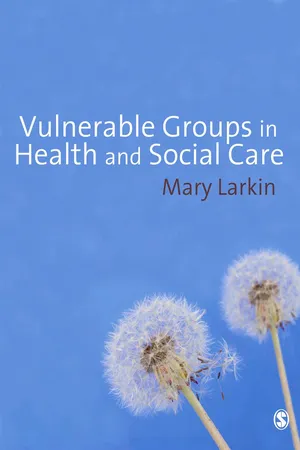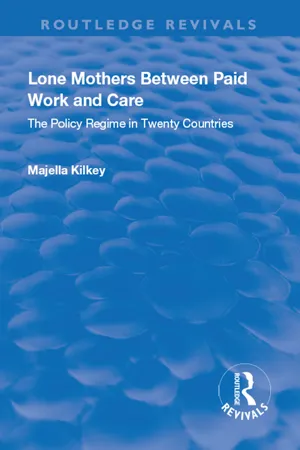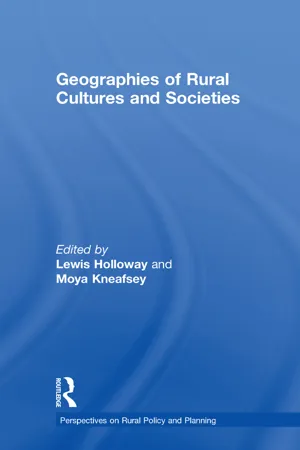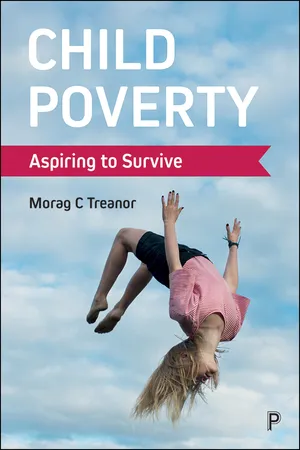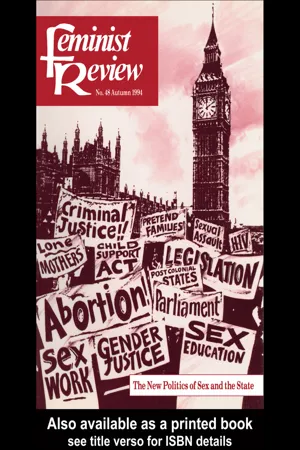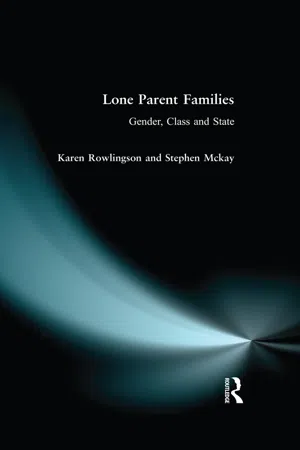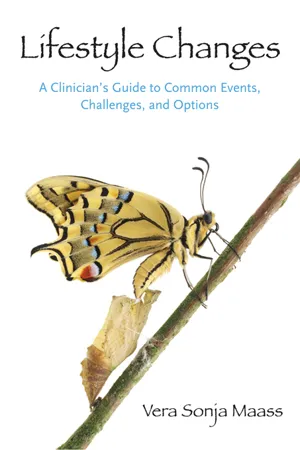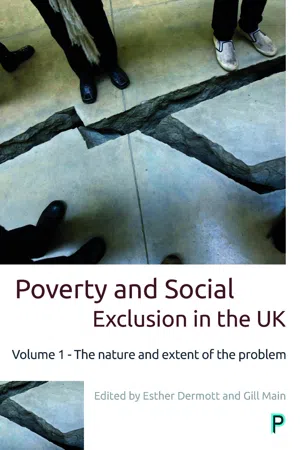Social Sciences
Lone Parenthood
Lone parenthood refers to the situation where a person raises a child or children without a partner or spouse. This can occur due to various reasons such as divorce, separation, or the choice to parent alone. Lone parenthood can present unique challenges and responsibilities for the individual, and it is an area of interest for researchers studying family dynamics and social support systems.
Written by Perlego with AI-assistance
Related key terms
9 Key excerpts on "Lone Parenthood"
- eBook - ePub
- Mary Larkin(Author)
- 2009(Publication Date)
- SAGE Publications Ltd(Publisher)
The number of lone parents has tripled since the 1970s and there are now 1.8 million lone-parent families in Britain. This represents one-quarter of all families, who care for a total of 3 million children. Britain has the highest proportion of lone-parent households in Europe (Chambaz, 2001; National Statistics, 2007a). The extent of lone parents’ vulnerability has featured in many policy documents on social exclusion, most notably those on the promotion of paid work and the eradication of poverty. This chapter will explore some of the key issues in relation to the social and political concerns about lone parents. These are their experiences, the costs of supporting them and the different approaches reflected in the political initiatives directed at them. As 90 per cent of lone parents are women, the focus in the discussions will mainly be on lone mothers. However, lone fathers will be addressed to illustrate particular points as appropriate.DEFINING LONE-PARENT FAMILIES
For official and statistical purposes a lone-parent family is usually defined as a divorced, separated, single or widowed mother or father living without a spouse (and not cohabiting) with his or her never-married dependent child or children. The reality is that definitional precision is elusive. One reason is that, as already indicated, there are many different routes into Lone Parenthood. These are divorce, separation, having a child as a teenager or during adulthood without having a partner or being married, and the death of a partner or spouse. Another variable is that, although nine out of ten lone parents are female, lone parents do include both men and women. The final complicating factor is that Lone Parenthood can be transitional. A summary of the changes in family structure that have occurred in recent decades is required in order to fully explain this factor. One such change is that there has been a move away from traditional nuclear and extended families and an increase in lone parents and reconstituted families - eBook - ePub
Lone Mothers Between Paid Work and Care: The Policy Regime in Twenty Countries
The Policy Regime in Twenty Countries
- Majella Kilkey(Author)
- 2018(Publication Date)
- Routledge(Publisher)
1 The presence of a male partner in the case of married and cohabiting mothers, enables the sharing of the responsibility for the material and emotional sustenance of a child/ren. In contrast, the absence of a male partner in the case of lone mothers, renders this responsibility solely or primarily that of the mother. It is essentially, therefore, the preclusion of the possibility of a division of labour (in the traditional sense or otherwise) in the realm of child-rearing responsibilities which has come to define lone motherhood in sociological terms.The validity of the assumptions on which such a definition is predicated, is questionable. The extent to which couples share responsibilities and resources is variable (Pahl, 1989; Bryson et al., 1994; Van der Lippe and Roelofs, 1995; Eurostat, 1997), and the situation of some partnered mothers may be akin to that of lone mothers. Similarly, some non-resident fathers may maintain responsibilities in the functions of child-rearing (see Bradshaw et al., 1999), such that the above distinction between a lone-mother family and a couple family is blurred.2 Moreover, the emergence of alternative living arrangements among couple families - ‘living apart together’, for example - may also weaken the distinction. Bearing these reservations in mind, this study was interested in lone mothers as mothers who in the absence of a male partner, must assume sole or primary responsibility for the material and emotional well-being of their children. We define them as such.In the academic and policy-related literature, a variety of alternatives to the term ‘lone mother (family)’ exist to describe the situation outlined above: ‘single mother (family)’, ‘solo mother’, ‘one-parent family’, ‘fatherless family’ and ‘disrupted family’, for example. The decision to use ‘lone mother (family)’ exclusively in this study emerged from a process of elimination of the alternatives on the basis of a number of criterion: clarity, accuracy and ideological neutrality. The term ‘single mother (family)’ was rejected, since it may invite ambiguity if lone mothers are distinguished by marital status, and the category of single never-married mother introduced. ‘One-parent family’, ‘fatherless family’ and ‘disrupted family’ were also deemed to be inappropriate, since they are inaccurate: the first two terms ignore the existence of a biological father, while the third disregards the fact that many lone-mother families are formed without disruption to an existing family unit. In addition to being rejected along the above lines, some of the alternative terms were precluded because of their rather strong ideological connotations. Thus for example, the terms ‘fatherless family’ and ‘disrupted family’ are often adopted in the literature which presents lone motherhood as a social threat (see for example, Dennis and Erdos (1992) and Blankenhorn (1994) on fatherless families, and Ní Bhrolcháin et al. (1994) on disrupted families), while the adoption of the term ‘solo mother’ by Hobson (1994) is a “political strategy to denote the strengths of women ‘flying’ as mothers on their own” (Duncan and Edwards, 1997a: 3). - eBook - ePub
- Moya Kneafsey, Lewis Holloway(Authors)
- 2017(Publication Date)
- Routledge(Publisher)
17). This is a perpetual and dynamic process with the conceptualization of Lone Parenthood continually being constituted, reproduced, changed and contested. For example, Song (1996) explores the conceptualizations of lone parents from the 1960s to the present day, pointing to the changing construction of the social and moral ‘problem’ of Lone Parenthood (see Brush, 1997, for a US case-study). Specifically, she points to the changing public and political concerns central to the conceptualization of Lone Parenthood, from illegitimacy in the 1960s, through a concern for the poverty of lone parents in the 1970s, to concerns about ‘dependency culture’, family breakdown and criminality in the 1990s. As such Lone Parenthood is not a neutral category, but a construction suffused with political and moral evaluations (Silva, 1996). There is an increasing body of literature which explores the sociality of Lone Parenthood and uncovers how lone parents are constituted in and by complex networks of power relations (Wallbank, 2001). This literature has pointed to the fact that in contemporary media, policy and political discourse, the lone parent family has been constructed in opposition to the ‘real’ family form discussed above. If the nuclear family represents the ‘good’ and ‘proper’ family then the lone parent family is the quintessentially ‘bad family’. The dramatic increase in lone parent families is viewed as concomitant with the disintegration of the traditional family form and the breakdown of society’s moral framework. In other words, lone parents have been held responsible for the decline in the traditional nuclear family. As Wallbank (2001) notes, lone mothers have been seen as ‘engineering the expulsion of fathers from the home for the sake of their independence’ (p. 3). Lone parents or ‘single mums’ as they are more commonly known have not only been vilified as a social and moral threat to society, but also as a financial burden - eBook - ePub
Child Poverty
Aspiring to Survive
- Treanor, Morag C.(Authors)
- 2020(Publication Date)
- Policy Press(Publisher)
Family separation and divorce is often the point at which many children experience poverty. Poverty can come hard on the heels of breakdown and separation, and children’s economic and emotional wellbeing can be particularly fragile as a result. However, poverty and emotional mal-being are not inevitable consequences of separation and divorce. The role of separated fathers in lone-parent families, particularly their financial contribution and involvement in their children’s lives, are explored. This chapter looks closely at how the state involves itself deep in the heart of family life in relation to support for children following separation or divorce. Although children are often the centrepiece in relation to policy rhetoric and development, their needs and concerns are often subsumed beneath the interests of the state and the perceived interests of parents. It explores the role of childcare and child maintenance policies in securing equity between children and between parents. Finally, it explores how they can establish financial adequacy and security; fundamental issues for children.Lone parents are not a homogenous groupAround 75 per cent of children in the UK live in two-parent families and 25 per cent live in lone-parent families (Lansley and Mack, 2015 ); although, from the disproportionate attention lone parents receive in political and media circles, you would be forgiven for thinking there were far more of them. The incidence of Lone Parenthood is increasing in many wealthy societies (Calder, 2018 ), although in the UK the proportion has remained stable for over ten years (Gingerbread, 2018 ). Lone Parenthood is not a fixed state as much as another stage in family life and is usually temporary (Treanor, 2018b , Zagel and Hübgen, 2018 ), lasting on average around five years in the UK (Lansley and Mack, 2015 ). The majority (90 per cent) of lone-parent households in the UK are female and only 10 per cent are male, proportions that have not changed in over a decade (Gingerbread, 2018 - eBook - ePub
Feminist Review
Issue 48: The New Politics of Sex and the State
- The Feminist Review Collective(Author)
- 2005(Publication Date)
- Routledge(Publisher)
se is bad for both the families themselves and for society in general and the state, therefore, should seek to discourage the formation of such families or, at the very least, not encourage them. This is a view which, despite the lack of evidence to support it, has gained even more ground recently with a series of speeches from government ministers—including Peter Lilley as Secretary of State at the Department of Social Security—critical of lone parents. Dennis and Erdos (1992) and Dennis (1993) have gained significant publicity for their argument that ‘families without fatherhood’ are destroying communities and society.Secondly, one of the central tenets of Conservative social policy in the 1980s was that the state had become too supportive, providing too much welfare, and this meant that individuals and families were no longer taking responsibility for themselves. This, it was argued, meant that a ‘culture of dependency’ had grown up in which people had lost the motivation to help themselves and instead relied on the state to meet all their needs. Separated, or unmarried, parents provided two prime examples of this abdication of personal responsibility. On the one hand there is the father, walking away from his family responsibilities and expecting the state to carry the cost. On the other hand there is the lone mother, increasingly relying on the state to provide an income. Receipt of benefits, or ‘dependency’ as such receipt was pejoratively termed, was thus increasingly defined as a matter of personal choice rather than external constraint.These ideas are linked in the concept of the ‘underclass’ as it was developed in the US (most influentially for British social policy by Murray, 1984, 1990). According to these accounts the underclass is mainly composed of unemployed men and single mothers, who have no incentive to work or to marry, and no motivation either to support their families or to help themselves out of dependency on the state. They are thus excluded from the labour market and excluded from the values of society as a whole (Smith, 1992). The US debate has had very strong racial overtones that are largely lacking in the UK context (Morris, 1994) but, that aside, these sorts of ideas have been influential in policy, especially towards unemployed people. Unemployment has been increasingly defined as a problem of unemployed people not wanting to work rather than a problem of lack of jobs, and this has led to a very harsh benefit regime for unemployed people in the 1980s, with cuts in benefit and restrictions on benefit entitlement (Atkinson and Mickelwright, 1989; McLaughlin, 1992). - eBook - ePub
Good Enough Mothering?
Feminist Perspectives on Lone Motherhood
- Elizabeth Bortolaia Silva(Author)
- 2013(Publication Date)
- Routledge(Publisher)
Chapter 10 Social Constructions of Lone Motherhood A Case of Competing DiscoursesAnn PhoenixSince the 1980s, the media in Britain and the United States have made many negative pronouncements on lone mothers. The notion of ‘feckless mothers’, who get pregnant in order to obtain welfare payments and housing and then rear children who are likely to become criminal, has been much aired by underclass theorists (such as Charles Murray 1990). Such notions have been picked up by politicians (including Bill Clinton as the Democratic president of the United States and Dan Quayle when he was the Republican vice-president) and by various British Conservative Secretaries of State. While many of these pronouncements have used moral arguments, of ‘responsible parenting’ and maintenance of ‘traditional families’, their proposed remedies to these ‘problems’ have been designed to reduce the economic dependence on the state of lone parents (who are predominantly lone mothers; Burghes 1993) and their children. They have produced a construction of lone mothers as ‘feckless’, wilfully responsible for the poverty that has been well documented to be a feature of lone parenting (Bradshaw and Millar 1991; Burghes 1993) and undeserving of either public sympathy or economic support.A major aim of the legislation and proposals regarding lone mothers (in Britain and the USA) has been to save the treasury money. Thus, in Britain there have been several measures to enforce ‘parental responsibility’. The most important are:- The setting up, in 1993, of the Child Support Agency (in operation of the 1991 Child Support Act) as an attempt to force errant fathers, rather than the welfare state, to be economically responsible for their children.
- Holding parents responsible for their under-age children’s crimes and hence any penalties enforced on children. There are also now regulations compelling parents to make provision for any children that their children (of up to 17 years of age) have (McLagan 1992).
- eBook - ePub
Lone Parent Families
Gender, Class and State
- Karen Rowlingson, Stephen Mckay(Authors)
- 2014(Publication Date)
- Routledge(Publisher)
Penalises those married. State has to pay for never-married lone parents. Social parenthood All parents living with children would be financially responsible for them until no longer dependent or no longer living in same household. Simplifies family relationships where second/third families are involved. Recognises the importance of social parenthood. State has to pay for lone parents. Might discourage lone parents from forming relationships and might encourage fathers to leave families. State support The state pays income to cover the costs of all children in all families regardless of structure and economic status. Recognises the importance of children. Eradicates child poverty (if set at appropriate level). Removes the need to chase maintenance payments. Reduces conflict over maintenance between parents. Expensive. Severs an important link between parents and children. Might encourage women to have more children.Perhaps the next step will be for such donor sperm fathers to be financially liable for their children? Take another example: if a married couple who have been trying to conceive a baby for many years eventually have a child through official IVF treatment (donor sperm) and then split up when the child is 5 years old, current British policy says that the ‘social’ father is financially responsible for the child rather than the biological father. So why are not all resident/social fathers responsible rather than biological fathers? Sperm donors may be a special case but they do lead us to question the absolute and unconditional nature of biological parenthood as a basis for child support.Marital parenthood
Despite its problems, biological parenthood is the current basis of child support obligations in Britain but it is not the only possible basis on which child support obligations could depend. As we have seen, marital parenthood has historically been the basis of child support obligations and there are still many who would argue today that marriage forms the most appropriate unit in which to care for children. In theory, a system could be constructed in which all married parents would be financially responsible for any children both while married and if they separate or divorce. Basing child support obligations on marriage would recognise marriage as an important and distinctive institution but it might also appear to penalise people who marry and then separate if these people are pursued for child support while others who have never been married are not liable in such a way. It may therefore create some disincentives to marry. It would also leave the state liable to pay for large numbers of children - those born to single mothers and to couples who separate after cohabitation. The growth in cohabitation and in single Lone Parenthood means that it no longer seems feasible to base a system of child support on this principle. - eBook - ePub
Lifestyle Changes
A Clinician's Guide to Common Events, Challenges, and Options
- Vera Sonja Maass(Author)
- 2008(Publication Date)
- Routledge(Publisher)
CHAPTER 6The Challenges of Single ParenthoodWhether through divorce or through widowhood, single parents face double difficulties and responsibilities. They are required to handle twice the strain with half the resources usually available in two-parent families. In traditional families, both parents assume responsibility for children’s health, education, behavior development, and emotional adjustment. Concerns over job-related difficulties, finances, disappointments in friendships, and other setbacks can be shared. In single-parent families, all responsibilities fall upon one who is already stressed by emotional adjustments to the loss or absence of the other spouse. Single parents face the challenge of combining several roles as they confront financial and nurturing responsibilities that in most cases previously were shouldered by two parents.The Disappearance of the Traditional FamilyThe so-called traditional family, dating back to the 1940s, seems like a myth today. Single-parent families are now considered to be significant components of society. Since 1970, there have been fewer than 20% of American families with the father being the traditional provider, the mother being a homemaker, and their two children attending school. Family statistics showed that in 2005, of all children in the United States younger than 18 years, 23% were living with a single mother and 41% of those were living in poverty (U.S. Census Bureau, 2005).Lack of financial resources is not the only challenging change in the transition to single-parenthood; additional responsibilities result in a drastic reduction of free time for rest or personal development as the task load increases. A single parent’s social life is virtually nonexistent. The fact of being unable to physically and mentally withdraw from the children for any significant period of time greatly increases the level of stress the single parent is experiencing. And it is not surprising to find that stress undermines parenting efficiency more in single-parent families than in two-parent homes (Conger, Patterson, & Ge, 1995). The increased stress without opportunity for relief might well be a contributing factor in the often cited finding that single parents are more likely than parents in two-parent homes to use harsh discipline measures (Simons & Johnson, 1996). - eBook - ePub
Poverty and Social Exclusion in the UK: Vol. 1
Volume 1 - The Nature and Extent of the Problem
- Dermott, Esther, Main, Gill(Authors)
- 2017(Publication Date)
- Policy Press(Publisher)
- How many days in the past 7 days have you, or your partner eaten an evening meal with your child/children? (Never/Some (1–3) days; Most (4–6) days/Every day)
Table 7.2: Percentage of parents living in PSE povertyFamily type (%) Lone parent Couple Poor 61 28 Rising/vulnerable 7 8 Not poor 32 65 N=2,642 490 2,152 In terms of the ability to access practical or emotional support, there are differences between lone and couple parents. There are some clear and statistically significant differences between couple and lone parents in terms of those who report they would get ‘not much’ support during a personal crisis, if they were ill in bed, in need of advice, if they had relationship problems, needed someone to look after the home or had a serious personal crisis: 11% of couple parents report low levels of support if in need of someone looking after the home, compared to 19% of lone parents. Lone parents are also significantly more likely to report low levels of support for household and gardening jobs and when ill in bed (25% compared to 8% for couple parents). Given that lone parents are the sole adult in a household (in our measure of Lone Parenthood), this finding seems to indicate that parents tend to rely on those they live with for practical help, while emotional support may be forthcoming from outside of their household.1 Indeed this disparity in being able to access practical help emerges despite the finding that lone parents are most likely to be engaged in frequent contact outside the household with both relatives and friends. Around 50% of all lone parents see relatives every day, and 40% see friends just as regularly; compared to lower levels of everyday contact with friends and relatives of around 30% or below for couples with and without children. The lower levels of support experienced by lone parents may therefore be a sign of lower availability of help within the household, which cannot be met by outside help despite high levels of social contact.Economising and educational resources
The economising practices of parents show, unsurprisingly, a strong correlation with income. Parents on a low income are more likely to have cut back in the last year across the board: skimping on food so that others would have enough to eat, buying second-hand rather than new clothes, as well as curtailing their expenditure on eating out, hobbies, hairdressers, clothes and visits to the dentist. Figure 7.1 shows that those with incomes below 60% of the equivalised median household after housing costs (AHC) are at least twice as likely to economise often on any of these items than those whose income is higher. If we inspect the whole income distribution, those in the bottom income quartile are roughly four times more likely than those in the top quartile to skimp on food so that others in the household would have enough to eat. Given that lone parents have much higher rates of poverty than couple parents, it is unsurprising that they are also substantially more likely to economise than parents living as couples. This is in line with what we might expect as those with fewer material resources are forced to cut back more and go without, but it goes against the political narrative that poorer people are profligate spenders who would have an acceptable standard of living if they were able to manage their finances better (for example, Iain Duncan Smith quoted in The Guardian, 2014). As Main and Bradshaw (this volume) indicate in chapter six
Learn about this page
Index pages curate the most relevant extracts from our library of academic textbooks. They’ve been created using an in-house natural language model (NLM), each adding context and meaning to key research topics.
